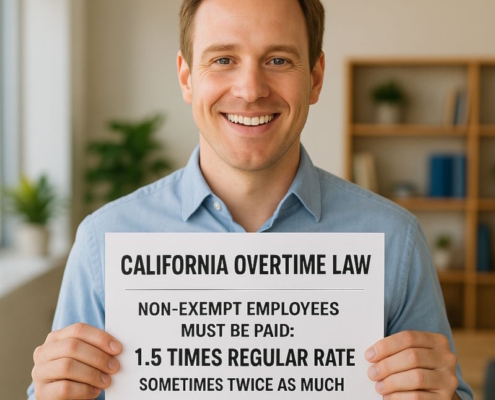What Is HR Analytics and How To Get Started
HR Analytics (Human Resource Analytics) is the process of collecting, analyzing, and applying employee data to improve a company’s workforce performance and business outcomes.
By Brad Nakase, Attorney
Email | Call (800) 484-4610
What does HR analytics mean?
HR analytics involves collecting, analyzing, and reporting HR data to understand what happened in the company’s past and how to move forward to improve employees and the company’s performance. HR analytics is known by many names, including people analytics, talent analytics, and workforce analytics. Whatever you choose to call it, the practice involves collecting, studying, and reporting Human Resources data. This permits your company to assess the impact of many different HR metrics on the business’ performance. In turn, this allows the owners of the company to make data-based decisions. That is to say, HR analytics is a data-focused approach toward HR management.
Fairly new to the business world, HR analytics has not received much study. Heuvel and Bondarouk offer the most complete definition, describing HR analytics as the methodical identification and appraisal of the individual drivers of business results.
Over the past hundred years, HR management has witnessed immense change. The field has developed from an operational discipline into a more strategy-based one. As evidence of this, consider how the word Strategic Human Resource Management became popular. HR analytics is just another change that fits within this long-term development.
People analytics means that you, an HR professional, do not have to rely on your intuition anymore. Rather, your decisions will be guided by cold, hard data. Analytics can also help with testing the efficacy of HR interventions and policies.
The pandemic has created significant changes in employment culture, including the growing trend of hybrid work and the increased utilization of automation. There is no denying that this is an age of uncertainty and disruption, which means it is critical that correct decisions are made.
In this article, our employment attorney for HR discusses HR analytics as follows:
How does HR use data effectively?
HR analytics is the collection of employee data related to employee tenure, retention rate, and turnover rates. HR analytics helps a company understand HR patterns, trends and use the data to forecast the future.
Human Resources has the unfortunate reputation as the least popular department in an organization. This is largely because HR is viewed in the same way as a doctor: you would rather not need one. Imagine yourself as an employee. When HR asks an individual to come see them, there is the expectation of bad news, whether it is a reprimand or even firing. Employees typically receive good news, such as promotions or raises, from their managers or supervisors.
Many people also consider HR to be old-fashioned due to the tendency of HR work relying on gut feeling. HR also is not responsible for raking in the profits or crunching numbers like Sales. Unlike marketing and finance, HR struggles to measure its success in a quantifiable way.
HR data analytics proposes to change this reputation. HR data allows new questions to be answered:
- What is your yearly rate of employee turnover?
- What percentage of your employee turnover is made up of regretted loss?
- Which workers are most likely to depart your company in the next year?
While most HR professionals can come up with an answer for the first question, the second is more difficult. To come up with an answer, an HR professional would need to use the combined resources of their Human Resources Information System (HRIS) and their Performance Management System. For the third question, further HR data and study is required.
All HR professionals gather immense quantities of data. The unfortunate reality is that this data is often left unused. But once you begin using this data to analyze the challenges unique to Human Resources, you are engaging in HR data analytics.
How does HR analytics benefit Human Resource management?
HR analytics help a company, and its Human Resource Department understand employee experience and satisfaction to increase its success. Just as analytics changed marketing for the better, Human Resources is undergoing a revolution. Analytics allows HR to do the following:
- Make better, data-driven decisions
- Defend the use of HR interventions
- Test the efficacy of HR interventions
- Make the transition from an operational partner to a strategic or tactical partner
Most Human Resources departments merely store recorded data. However, this does not make the cut in today’s data-driven world. The simple maintenance of records does not add any strategic value to a business. Turning data into information, and using that information to produce insight brings HR into the decision-making that takes place on a strategic level.
What are examples of HR Analytics?
When getting started with Human Resources analytics, a professional will need to merge HR data from various systems. Let’s say you want to quantify the impact of worker engagement on the company’s financial performance. To assign a number to this relationship, you will need to combine your performance data with your yearly engagement survey. Thus, you may calculate the effect engagement has on the company’s financial performance across departments and stores.
The insights produced by HR analytics will change critical areas of Human Resources. For example, areas like performance management, learning & development, and recruitment will undergo change.
With HR analytics, you will be able to quantify the impact your learning and development budget has on the business. You might also predict which new hires will be the company’s best performers in a few years. It is also possible to predict which new employees will leave the organization within a year. This knowledge will impact your selection and hiring decisions and procedures.
How do you start using HR analytics?
To get started with HR analytics, begin with a simple question like “which employees are the most likely to progress and attain leadership positions?” This question may be answered using basic statistics. This procedure assists in quantifying the dynamic between people’s skills and company results. Thus, analytics can help a company monitor turnover, absenteeism, performance, and burnout.
If you learn what makes your company’s employees operate, you can achieve a better work environment and identify leaders for the future. Think about how useful it would be to know which employees are most likely to leave an organization. This kind of data allows for long-term planning and succession management.
Once you have asked the relevant question, you must then select the proper data from various systems. This data will then be merged, cleaned up, and studied. The analysis will lead to valuable insights.
That said, not every insight is interesting or worthwhile for the company. For this reason, you need to raise questions about matters that the HR department can address. For instance, you cannot influence economic trends, such as recessions. You can, however, influence engagement levels and management styles. The right questions result in actionable analysis.
How can HR analytics shape a company?
HR analytics will employee survey results to turnover data, enabling the Human Resources department to measure the business impact of its employee policies and reasons for employee turnover. As is apparent, HR data analytics is immensely valuable for a business. With the help of statistics, HR can predict what the future workforce will look like. This can help managers measure the economic impact of HR practices. The greatest purpose of HR data analytics is measuring HR’s impact on performance. This is usually done through computing a Return on Investment, or ROI. This is the most powerful tool HR has to increase its strategic importance.
Understanding the impact of Human Resources policies can help HR rid itself of its old-fashioned image. By taking the guesswork out of the field, HR may align itself with business goals, adding value to companies.
Facts about people analytics
Business success
- According to Nucleus Research, for every dollar spent, analytics pays back $13.
- Over 80% of analytical companies have a minimum of one HR analytics project.
Soft integration
- 65% of organizations with developed analytic programs have HR managers and business partners who can translate outcomes into clear actions.
- Almost 90% of top-performing businesses claim that analytics are part of the HR role description.
Skills gap
- A mere 20% report their biggest challenge with data analytics to be a lack of analytical skills.
- About half of companies reveal that they have no professionals with analytical or statistical knowledge.
Challenges/limitations
- Less than 10% of executives believe in the quality of their Human Resources data.
- Almost 70% of professionals claim that the quality of data impacts analytical success.
- One-fifth of HR departments do not have the relevant skills to analyze data.
Data Integration
- Almost 70% of businesses are incorporating data analysis to establish a database for People Analytics.
- Almost 90% of the top companies have high data quality.
- About 30% of companies list poor data quality as the biggest challenge to performing data analytics.
- Almost 80% of companies claim that scattered data across various HR systems is the main analytical challenge.
Reporting
- HR analytical ability is directly tied to HR reporting.
Have a quick question? We answered nearly 2000 FAQs.
See all blogs: Business | Corporate | Employment
Most recent blogs:
































